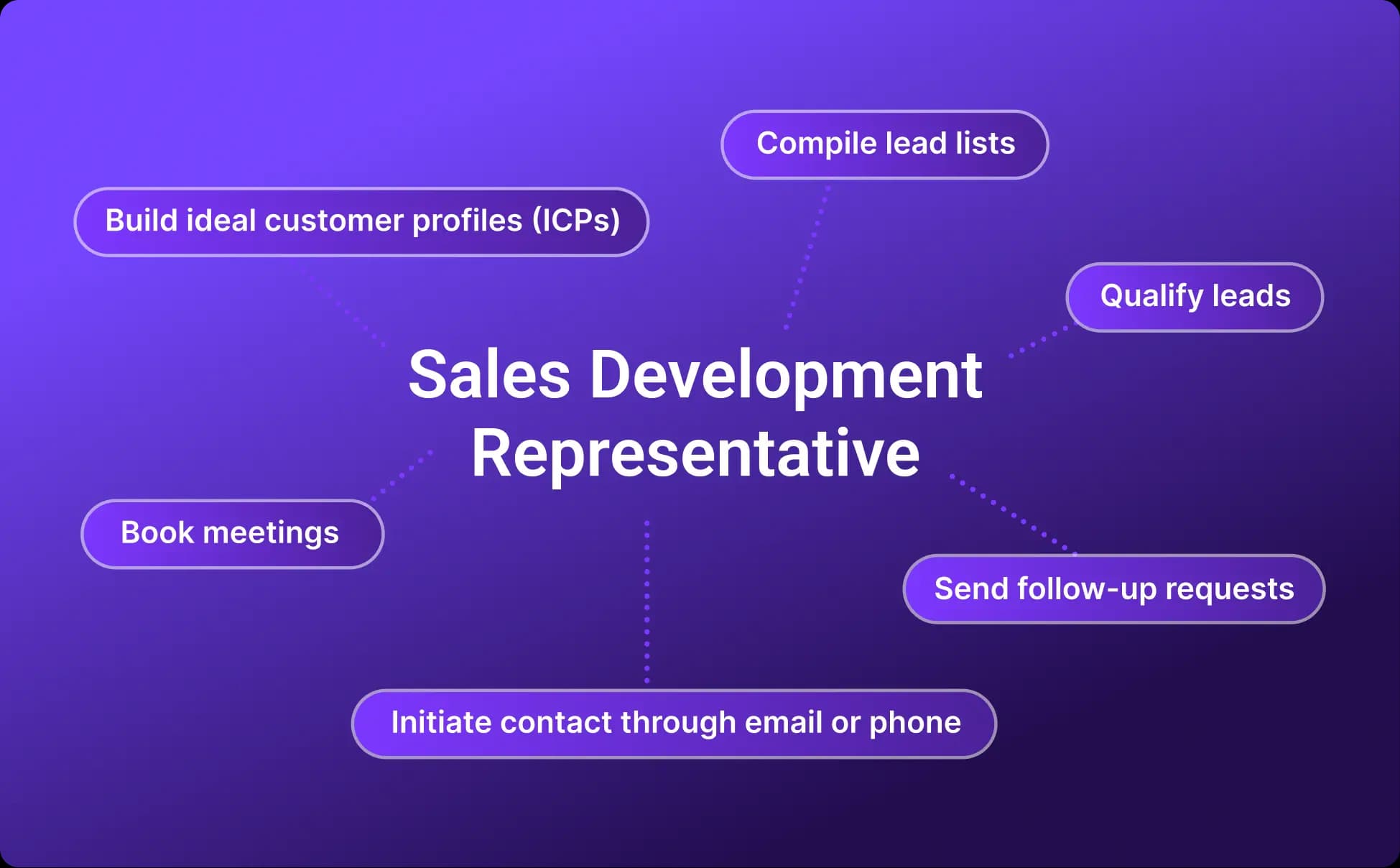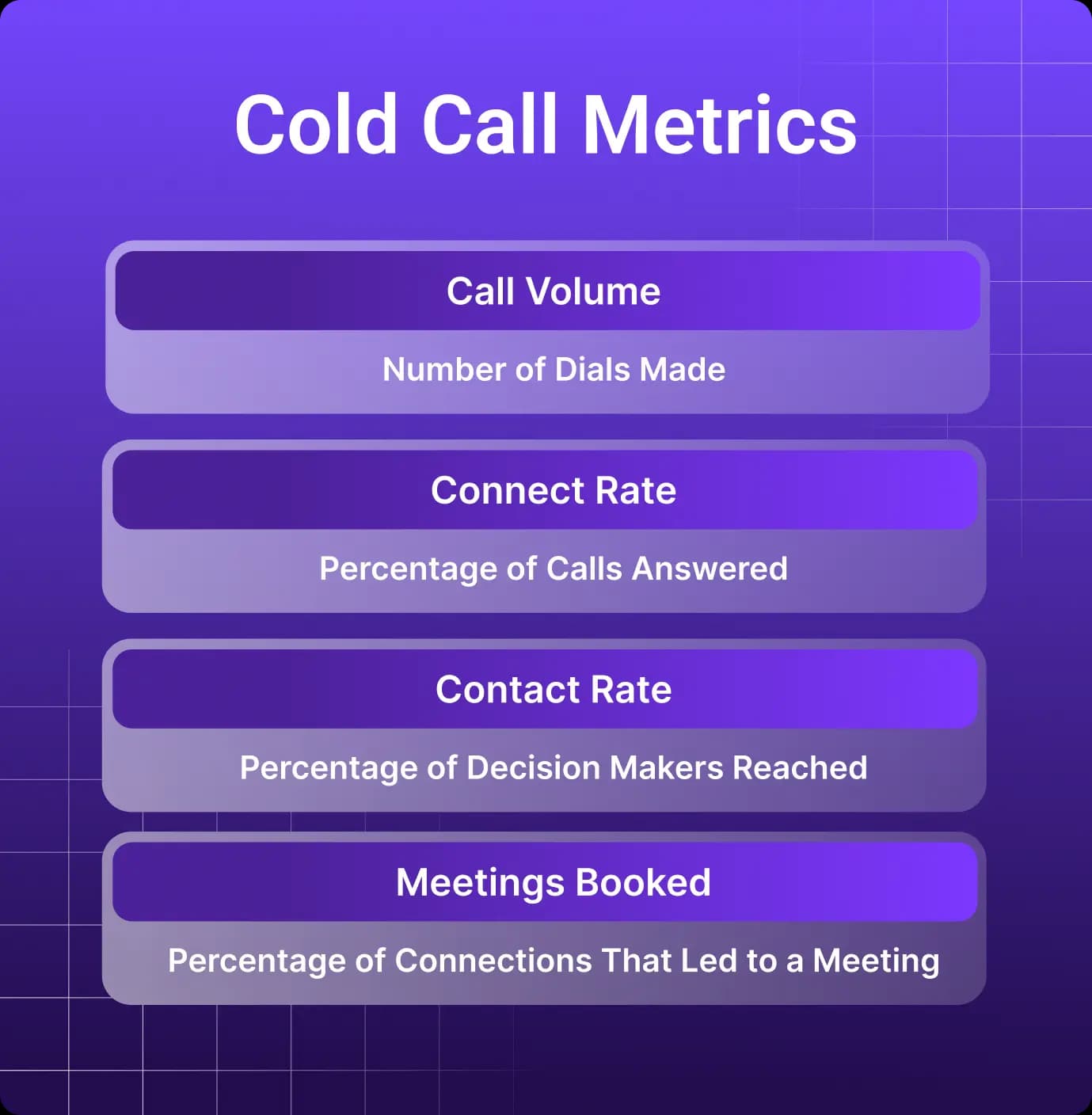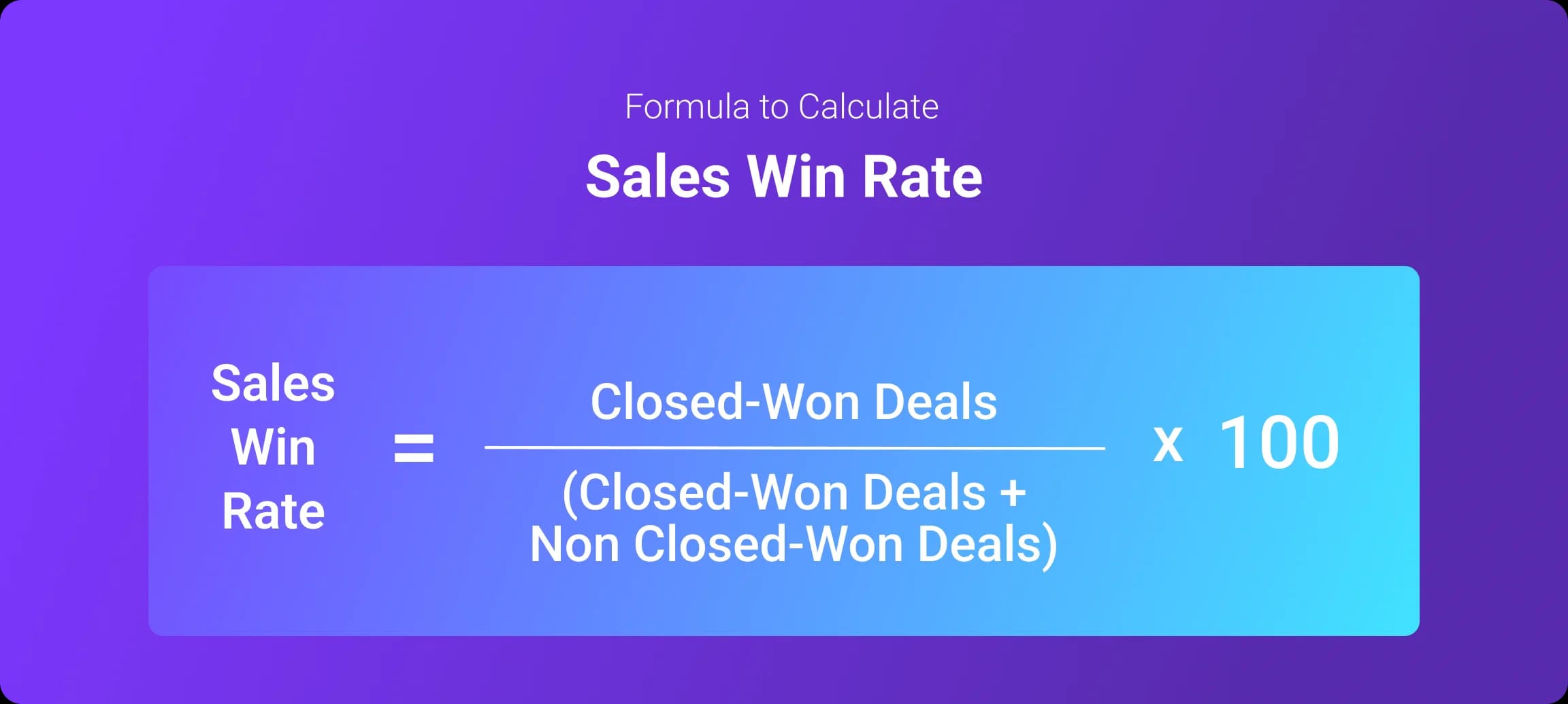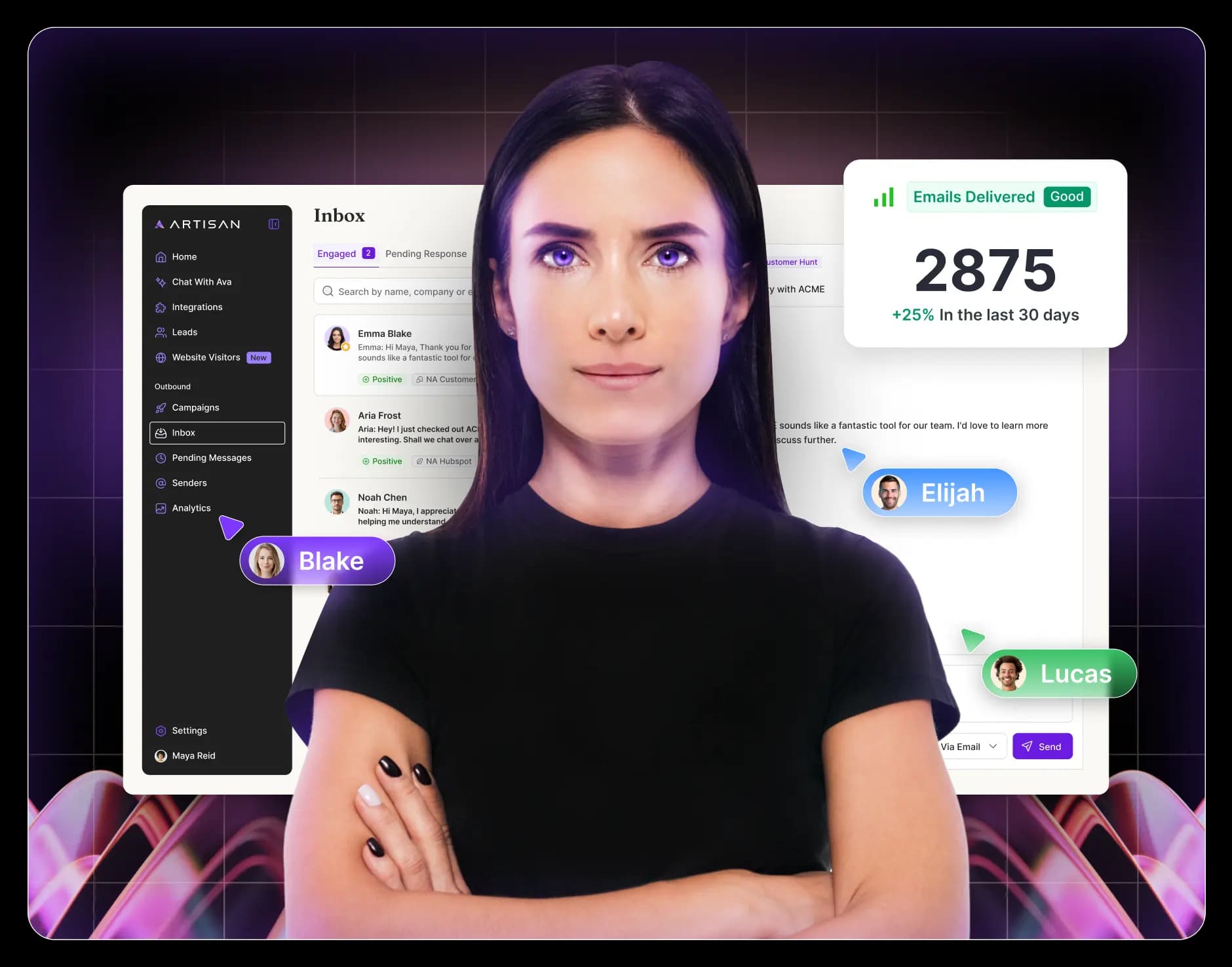What’s the best measure of a sales development representative’s performance?
Volume of calls made?
Email response rates?
Number of qualified leads passed to account executives?
Or perhaps you prefer the old, unarguable failsafe of SDR-attributed revenue.
There’s no right way to measure SDR success. Some industries rely on cold calls. Others on bulk email. Sometimes, it’s common practice for SDRs to host preliminary meetings, sometimes it’s not. The list goes on.
But understanding which metrics are available lets you create a tailored framework for setting realistic goals and optimizing performance. One that’s suited to the needs of your organization.
Inbound vs Outbound SDR Teams
SDRs are responsible for generating and nurturing leads and booking meetings. In sales lingo, they bring leads into the top of the outbound funnel or fill the start of the sales pipeline.
SDRs usually do a mix of the following:
Build ideal customer profiles (ICPs)
Compile lead lists
Qualify leads
Initiate contact through email or phone
Send follow-up requests
Book meetings
Increasingly, SDRs have been using AI to help streamline and scale the tasks listed above, and Artisan’s virtual assistant, Ava, is an excellent example of an AI SDR.

Usually, an SDR’s appointment and meetings rate is the main benchmark of their success, but this isn’t always the case. In addition to booking meetings, SDRs are responsible for passing information to account executives (AEs) to help them close deals.
Sales teams tend to comprise three core, often overlapping roles:
Business development representatives (BDRs) are responsible for finding and qualifying leads.
Sales development representatives (SDRs) nurture leads and work towards booking meetings.
Account executives (AEs) are the most senior salespeople and are tasked with closing deals.
In addition, SDRs can be either inbound or outbound (or both):
Inbound SDRs nurture relationships with inbound leads—leads that have initiated contact with the business because of marketing efforts. Metrics like lead response time and lead conversion rate are most important here.
Outbound SDRs pursue cold leads who have had no or little interaction with the business. For outbound SDRs, volume-based metrics (call and email) are important in addition to conversion metrics.
So, there you have it. That’s a fairly complete overview of what SDRs do and where they fit into the sales cycle and sales team structure.
Now, let’s take a look at those all-important metrics.
AI SDRs can assist sales teams by taking care of routine, repetitive tasks like lead qualification and management of cold email campaigns. Artisan’s virtual AI assistant, Ava, has access to a database of 300 million leads and can create and send personalized email at scale. If you’d like to see how Artisan can help your human SDRs exceed their targets, get in touch to book a demo.
8 Key SDR Metrics to Track
Here are the right metrics that are most important for tracking SDR performance:
Number of dials and connects
Emails sent
Email response rate
Lead-to-opportunity conversion rate
Meetings and appointment booked
Lead qualification rate
Follow-up time
Revenue generated
Let’s look at each one in depth.
1. Number of Dials and Connects
Call volume refers to the number of dials made by your SDRs. It measures the efficiency of your sales team, not necessarily the quality of their cold calling skills. It’s an important metric because it gives you vital information about your SDRs’ practical capabilities and acts as a baseline for improving other metrics.
Your connect rate tracks the amount of calls that are answered. Sometimes, this is further refined by measuring contact rate, the number of dials that connect with a decision maker or buyer. A high dial volume but low connect rate could indicate that the quality of your lead data is poor,
Your SDRs’ cold call success rate is measured by calculating the percentage of connections that result in a meeting.

2. Emails Sent
“Emails sent” measures the number of emails your SDRs are sending over a given period. It can be further broken down into deliverability, the percentage of emails that reach an inbox, and open rate, the percentage of emails that are read.
Improving email volume is simply about finding more leads and sending more cold emails, and AI sales assistants like Artisan can drive scale.
Improving deliverability requires good data hygiene practices for up-to-date email addresses, domain warmup best practices, and time-zone adjustment.
Improving open rates is about tightening ICP-lead alignment and creating compelling subject lines.
Outbound email is relying on volume more and more, which isn’t necessarily a bad thing. There’s no doubt that cold email works—we see excellent results consistently with our clients at Artisan—but buyers have become more immune to cold pitches, which highlights the need to track this metric.
If you’d like to see how Artisan’s virtual AI assistant Ava can help with all your email send metrics—volume, deliverability, and open rates—get in touch to book a demo.
3. Email Response Rate
Your email response rate measures the percentage of emails sent that generate a response. It’s calculated by dividing the number of responses over a given period by the number of emails sent.

Your email response rate essentially measures how well cold leads align with your ICP and the quality of the emails your SDRs are sending.
You can improve your email response rate with the following methods:
Ensuring cold leads closely match your ICP
Sending emails at the right time
Personalizing email copy
Improving the relevance of your offer
Using an open-ended question like “Would you like to learn more?”
Running A/B tests to find higher-performing variants
4. Lead-to-Opportunity Conversion Rate
An SDR’s lead-to-opportunity conversion rate is important because it covers the whole portion of the broader sales process in which they’re involved. An opportunity is defined as a lead with a very strong likelihood of buying. It’s the responsibility of the AE to close the deal.

There are three main ways an SDR can improve their lead-to-opportunity conversion rate:
Create more specific and ICP-focused filtering criteria (before outreach is started)
Improve the quality of outbound email and phone outreach
Ensure accurate qualification criteria that don’t exclude viable leads
In addition, the quality of the lead database and scraping techniques SDRs are using is another key consideration. It’s vital that SDRs have access to up-to-date lead data.
5. Meetings and Appointments Booked
Meetings (or appointments) booked is the average number of meetings your SDRs are scheduling for AEs. The cross-industry average has remained relatively stable over the last decade, with a typical SDR booking around 15 meetings per month (although there is variability between industries).
The average number of meetings booked is a good comparative figure. If your SDRs are booking more meetings with qualified and semi-qualified leads over time, it shows that your processes are becoming more efficient and their skills are improving.
AI can significantly increase an SDR’s monthly number of meetings booked by handling many time-consuming tasks and scaling early-stage prospecting.
6. Lead Qualification Rate
An SDR’s lead qualification rate measures how many cold leads become sales-qualified leads (SQLs). An SQL is a lead that has shown a strong interest in buying but is not quite “hot” enough to be considered an opportunity.

BANT is a popular framework for gauging if leads meet buying criteria:
Budget. How much is a lead willing to spend?
Authority. Are they the right decision maker?
Need. Are they experiencing a problem your product solves?
Timeline. How long do they need to make a decision?
Depending on the way your sales development team works, AEs may take over at the SQL stage or at the opportunity stage.
An SDR’s lead qualification rate matters because it measures two important skills—lead filtering and nurturing. If your SDRs are not finding cold leads aligned with your ICP, their lead qualification rate is likely to be poor. Similarly, SDRs can help boost the willingness of a lead to buy through effective nurturing.
7. Follow-Up Time
Follow-up time matters. The average lead response time stands at a whopping 47 hours. Yet engaging with leads within five minutes of receiving a response increases conversion rates by 400%.
For SDRs, follow-up most typically refers to the time that elapses between receiving a response to a cold email or voicemail. Given practical constraints and working hours, this should be as fast as possible.
Follow-up time can be tracked using your outbound sales software and should be applied to all stages of your sales funnel, including replies to cold emails, follow-up after meetings, and responses to requests for supplementary information.
8. Revenue Generated
Overall sales revenue is a likely indicator that your SDRs are performing well. Measured over time, it acts as a barometer of the effectiveness of your training and outbound automation initiatives.
You can determine the contribution of your SDRs to revenue by accounting for win rate. For example, if the win rate of your team’s AEs remains the same but SDR metrics like cold-lead-to-opportunity or cold-lead-to-SQL have increased, then revenue increases are attributable exclusively to SDRs.
You can track the revenue performance of individual SDRs by linking their lead generation activities to closed deals in your CRM.
Artisan’s AI virtual assistant Ava can automate key parts of your early-stage outbound sales process. This results in more new leads, more diverse lead sources, and sales development reps that are free to focus on the all-important human touch. Get in touch to book a demo.
How to Measure and Analyze SDR Metrics for Success
So you know which metrics you need to measure—both activity metrics and performance metrics—but how do you actually go about tracking them?

Utilize CRM Software
Your customer relationship management (CRM) platform is the hub of lead monitoring for your sales development team.
By tracking leads through the various stages of your sales cycle, your CRM allows you to access all important conversion metrics.
You can also often sync your CRM with third-party tools to measure activity metrics like phone calls made and emails sent. Hubspot and Salesforce are the web’s leading SaaS CRMs.
Set Clear Goals and Benchmarks
Ah, the good old quota.
Quotas, benchmarks, goals—they’re all important for creating a framework for your sales team. However, it’s essential that goals and benchmarks are clear, realistic, and based on historical performance data.
Realistic expectations form a solid foundation on which incremental improvements are possible. They should adhere to SMART guidelines: Specific, Measurable, Achievable, Relevant, and Time-Bound.
Regularly Review and Analyze Metrics
Your sales team’s key performance indicators (KPIs) are practical tools, and they should be reviewed regularly.
In-depth analysis of a range of key metrics will give you insights into where your sales and marketing teams are underperforming. You can then make improvements accordingly.
For example, you may have a very high email response rate, indicating effective email outreach practices. However, the number of meetings booked may be low, showing that follow-up needs attention.
Data visualization tools—which are usually available in most CRMs and sales enablement platforms—make it easier for your team to process data and form insights.
Boost Your Team Efficiency with AI SDRs
Many salespeople are skeptical of AI. They don’t see how it can successfully complete tasks that have traditionally required a strong human component. However, this is a misunderstanding of the nature of AI in SDR-focused sales processes.
AI supplements human lead nurturing. It automates those repetitive, time-consuming tasks that are nonetheless a fundamental aspect of a successful lead generation and sales flow.
For example, Artisan’s virtual AI SDR, Ava, can handle all of the following tasks:
Filtering from a database of 300 million leads
Lead enrichment and hygiene checks
Email domain warmup
Email copy personalization that mirrors human input
Automated follow-up
Time-zone adjustment
A/B split testing of email templates
Data analysis and practical insight generation
AI can assist with practically all your outbound SDR metrics. According to McKinsey, 70% of businesses using AI report increased sales earnings.
If you’d like to see how an advanced AI platform can boost your SDR sales metrics and boost sales revenue, get in touch with Artisan to arrange a demo.

